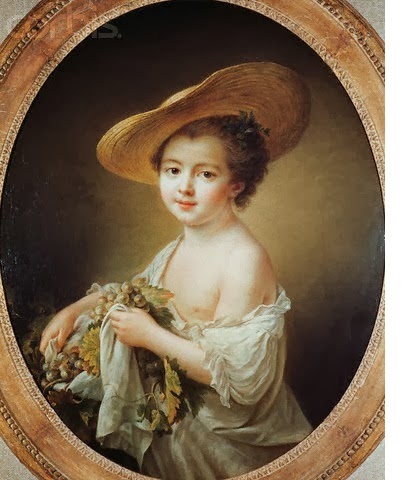 THE HOST: Claude-Adrien Helvétius
THE HOST: Claude-Adrien HelvétiusA former tax-farmer, Helvétius had given up his lucrative office five years previously, purchased the purely honorary one of maître d'hôtel de la Reine and devoted himself to writing and research. A year later he had married Mme de Ligniville-d'Autricourt, the niece of Madame de Graffigny, a witty and lavish hostess, who ably assisted her husband in making of the Helvétius mansion, rue Sainte-Anne, a centre for convivial and freethinking gatherings. In 1755 the unpleasantness and notoriety of the affaire De l'Esprit still lay in the future and there was little to mar this luxurious, refined and, by mid-century, slightly old-fashioned world of letters and conversation.
THE GUEST OF HONOUR: Bernard le Bouvier de Fontenelle
 In an age when men died young, Fontenelle, in his late nineties, was a living link to the age of Racine and Corneille and, ever obliging, happily to play his role as grand old man of the Enlightenment. Helvétius self-consciously modelled himself on the libertins of old and must have been delighted that Fontenelle, though now deaf and almost blind, still managed from time to time to be guest of honour at the rue Sainte-Anne.
In an age when men died young, Fontenelle, in his late nineties, was a living link to the age of Racine and Corneille and, ever obliging, happily to play his role as grand old man of the Enlightenment. Helvétius self-consciously modelled himself on the libertins of old and must have been delighted that Fontenelle, though now deaf and almost blind, still managed from time to time to be guest of honour at the rue Sainte-Anne.THE OCCASION: A carnival ball, opened by Fontenelle with Helvétius's little daughter on 7th February 1755.
 |
| François-Hubert Drouais, Elisabeth-Charlotte Helvétius later comtesse de Mun |
"At the beginning of the month (February 1755) M.Helvétius gave a fine ball which was opened by M. de Fontenelle who, a few days later, entered his hundredth year, with the younger Mademoiselle Helvétius who was only a year and a half old. Fontenelle still bowed to her and kissed the little girl. Then he took the daughter of Madame d'Epinay, who was seven, bowed again and kissed her too. What a lot of trouble for a gallant of ninety-nine years; two bows, two compliments, two kisses; all joking apart, it's extraordinary, the man still has his wits about him". (vol.2,p.80)
And also there.....
It comes as a bit of a surprise to learn that another guest at the ball was none other than Jean-Jacques Rousseau! At this time, having just returned from Geneva to Paris, he still counted the leading philosophes among his closest friends and accepted the hospitality of Helvétius eagerly. Although Rousseau speaks often in his Confessions of his extreme shyness and gauche behaviour in polite society, others testify to his charm and brilliant conversation. In one of his letters he reported attending the ball and witnessing there a "most agreeable sight": "It was the worthy Fontenelle who opened the ball with a young lady of four. I advised the mother to point out to the girl the singularity of the occasion, something she will look back on in her old age with pleasure". (A bit irritating this, since the contrast in age was clearly the whole point.)
It is a little confused which of Helvétius's two daughters is being referred to. Despite Colle, it is usually assumed to be the elder, Elisabeth-Charlotte, who was born on 3rd August 1752, making her two-and-a-half at the time. The second daughter Geneviève-Adelaide, born on 25 January 1754, had just turned one. Neither girl would have been old enough to remember the event.
 |
| Madame la comtesse de Belsunce, by Carmontelle, 1775 |
The other little girl, Madame d'Epinay's daughter Angélique-Louise-Charlotte, later comtesse de Belsunce, lived on until 1824. Thus she at least could have boasted in the age of Chateaubriand and Byron of her kiss from a friend of Racine and Corneille.
References
I first came across a mention of the ball long ago in R.J. White's Europe in the eighteenth century (1965), a nice gossipy book, though not much use for passing your A-level! It is also written up in the late Maurice Cranston's biography of Rousseau, vol.2: The noble savage (1991), p.2-3.
Charles Colle's Journal historique: ou, Mémoires critiques et littéraires is on Google Books. Colle is not good on ages; he has Fontenelle's wrong too. Fontenelle died on 9th January 1757, just a month short of his hundredth birthday (11th February), so in February 1755 he would in fact have turned 98 years old and entered his 99th year.


How the title of the portrait by Drouais was attributed as being Miss Elisabeth Charlotte Helvétius ?
ReplyDeletewhich is proving this attribution ?
if it's one of the girls of the ball why not Miss d'Epinay ?
There are different versions of this portrait with varying titles on the internet. It is usually identified as the comtesse de Mun who was Elisabeth-Charlotte, but sometimes the Christian names of the two Helvetius sisters get muddled. The new critical edition of Helvetius's correspondance has the accurate description if you need an authoritative source: See p.406 of:
Deletehttp://books.google.co.uk/books?id=FpmzBfo5dRgC&source=gbs_navlinks_s
The painting is a portrait, nothing to do with the ball as such. I just picked it out to put in the post as an illustration because it is one of Helvetius's daughters.